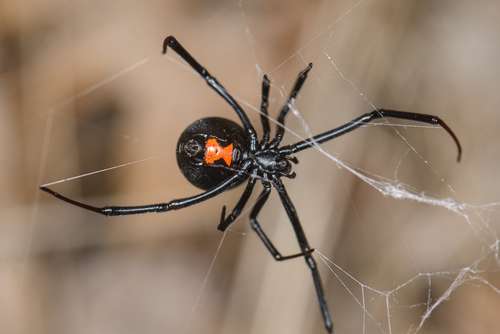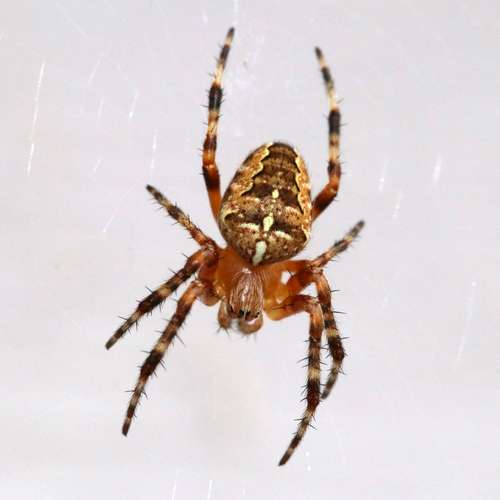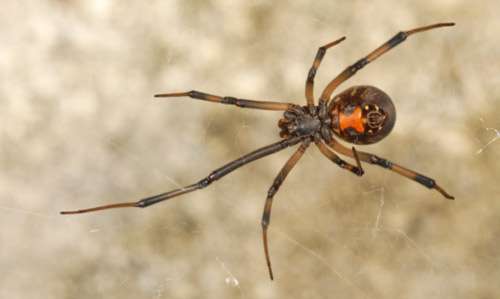
Western black widow spiders, sometimes known as western widows, are venomous spiders that can be found throughout western parts of North America. The female’s body is 14–16 mm (1/2 in) long, black, and frequently has a red mark in the shape of an hourglass on the lower abdomen. This “hourglass” symbol might be either yellow or, very rarely, white. The species’ male is almost half as long as the female and typically has lighter abdominal striping over a tan background. Previously classified as a subspecies of Latrodectus mactans, the population is also connected to the northern species Latrodectus variolus. The species, like others in the genus, makes irregular or “messy” webs. In contrast to other spiders’ spiral or tunnel-shaped webs, the strands of a Latrodectus web appear to be unorganized.
Geographical Distribution
Latrodectus hesperus, a species of western black widow spider, is found in the drier parts of the United States. All four of the American Southwest’s deserts have this species.
Habitat
Black widow spiders are seen living beneath ledges, rocks, vegetation, and various kinds of detritus. Webs are typically constructed close to the ground. Sometimes webs form within trash cans, in rubbish heaps, under houses, or nearby. Black widows are more likely to choose spaces inside of homes to reside or spin their webs when the weather shifts from warm to cold. Homeowners should eliminate items where black widows can hide in order to stop them from entering a house.
Description of the body
- Black and glossy spiders are the norm for adult female black widows. The reddish hourglass appearance on the underside of the abdomen is how black widows are most frequently identified.
- Females are typically 3.5 cm long on average, with a rounded belly. Male adults are just half as big as female adults. Despite having smaller bodies than females, they have longer legs. Dorsally, males have bands and dots that are yellow and red.
- Black widow eggs are typically white; however, they can occasionally be yellowish-white. They gradually turn black as they age. The amounts of red and white on the bodies of mature black widows might differ.

Feeding Habits
Similar to the majority of arachnids, Western black widows typically eat insects. Black widows may capture their prey because a web’s silk contains chemicals that are adhesive. Coarse silk is used to make the web. L. hesperus diet is Beetles, cockroaches, and flies are all. Black widows use their tiny, hollow teeth to suffocate their victims by injecting poisonous venom into their victims. Black widows pierce their prey’s body with tiny holes, then proceed to suck out the fluids inside. The bug is not completely digested by the black widows because they only consume liquid-based food.
However, the spider’s digestive secretions are injected into the insect meal, helping to increase the amount of the food that the spider can eat. Black widows leave the exoskeleton of their victim insects behind. These bare shells are visible close to the spider’s web. After mating, a female black widow may occasionally consume males of the species.
Defensive Mechanism
The omnivorous and larger than the black widow mice are some predators that the black widow spiders must contend with. A piece of viscid silk can be ejected by juveniles and female adult L. hesperus in the direction of possible predators. Although this silk is non-toxic, it can deter most predators because of its mechanical discomfort. Adult males, on the other hand, are unable to manufacture this protective silk, most likely due to their need to store energy for reproduction throughout their relatively brief lives. Females, who are under a lot of predation pressure, value this defensive behavior greatly. Black widow spiders weave their webs extensively during night, when ground mice are most active. Mice and other predators can easily attack from below if the webs are low to the ground. If there is no defensive behavior, such attacks are usually successful because the spider will remain relatively motionless at the web hub.
Importance in Humans Life
Positive
The only genuine benefit that black widow spiders provide for people is that they devour insects. Western black widows are frequently observed close to human habitations, making them potential pest bug predators.
Negative
Black widow spiders are potentially lethal creatures. They have venom that is fifteen times as deadly than rattlesnake venom. Only a tiny amount of venom is injected into the prey when a spider bites. Rattlesnakes are thought to be more harmful because their bite causes their victim to get more poison. But it’s crucial to remember that a human would probably perish if exposed to a significant dose of the black widow’s poison. Despite this, most bites do not result in death. The black widow’s bite can result in internal issues and is more likely to be painful. Both stomach pain and muscular swelling in the foot are examples of such adverse effects. Dry mouth, increased sweating, and puffy eyelids are among the milder symptoms.
As Pet
They don’t make good pets because they have highly deadly venom in them, proliferate quickly, and dwell close to people. In reality, you must get rid of a western black widow if you locate one in your house by applying insecticides and substances like vinegar. Their egg sacs should be removed, but no bare skin should ever contact them.
Table





